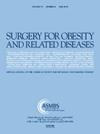胃旁路和袖式胃切除术后的牙科结果:一项基于登记的研究。
IF 3.5
3区 医学
Q1 SURGERY
引用次数: 0
摘要
背景:减肥手术已被证明会对口腔健康产生负面影响,这反映在术后龋齿相关牙科干预的增加上。目的:本研究的目的是比较Roux-en-Y胃旁路术(RYGB)和袖式胃切除术(SG)后的牙科干预率。设置:全国注册制(瑞典)。方法:这项两阶段匹配队列研究纳入了2011年至2015年间在斯堪的纳维亚肥胖手术登记册中登记的所有接受RYGB (n = 26,594)或SG (n = 3416)的成年人。基于几个协变量,使用倾向评分匹配将SG患者与RYGB患者进行匹配。随访时间为术后3年。从牙齿健康登记中收集牙齿变量,包括拔牙、修复干预(牙齿填充)和牙髓干预(根管治疗)。结果:共纳入RYGB患者3317例,SG患者3317例。两组术后牙齿事件发生率均有所增加。RYGB患者术后的事件发生率明显高于SG,包括所有干预措施,修复和牙髓干预措施。结论:RYGB对补牙和拔牙效果的负面影响明显高于SG。原因尚不清楚。需要更多的研究来重复这些发现,了解其机制,并进一步描述手术方法的意义。本文章由计算机程序翻译,如有差异,请以英文原文为准。
Dental outcomes after gastric bypass and sleeve gastrectomy: a register-based study
Background
Bariatric surgery has been shown to cause a negative impact on oral health, as reflected by postsurgical increase of caries-related dental interventions.
Objectives
The aim of this study was to compare dental intervention rates after Roux-en-Y gastric bypass (RYGB) and sleeve gastrectomy (SG).
Setting
Nationwide and register-based (Sweden).
Methods
This 2-staged matched cohort study included all adults who underwent RYGB (n = 26,594) or SG (n = 3416) between 2011 and 2015, registered in the Scandinavian Obesity Surgery Register. Propensity score matching was used to match SG patients to RYGB patients, based on several covariates. The follow-up time was 3 years after surgery. The dental variables were collected from the Dental Health Register, including tooth extractions, restorative interventions (dental fillings), and endodontic interventions (root canal treatment).
Results
In total, 3317 RYGB and 3317 SG patients were included. Both groups showed increased dental event rates postoperatively. RYGB patients had significantly higher event rates compared with SG postoperatively regarding all interventions, restorative and endodontic interventions.
Conclusions
The negative effect on dental outcomes in terms of dental fillings and tooth extractions were higher after RYGB than after SG. The reasons are not clear. More research is needed to replicate these findings, to understand the mechanisms, and further delineate the significance of the surgical method.
求助全文
通过发布文献求助,成功后即可免费获取论文全文。
去求助
来源期刊
CiteScore
6.70
自引率
12.90%
发文量
570
审稿时长
56 days
期刊介绍:
Surgery for Obesity and Related Diseases (SOARD), The Official Journal of the American Society for Metabolic and Bariatric Surgery (ASMBS) and the Brazilian Society for Bariatric Surgery, is an international journal devoted to the publication of peer-reviewed manuscripts of the highest quality with objective data regarding techniques for the treatment of severe obesity. Articles document the effects of surgically induced weight loss on obesity physiological, psychiatric and social co-morbidities.

 求助内容:
求助内容: 应助结果提醒方式:
应助结果提醒方式:


